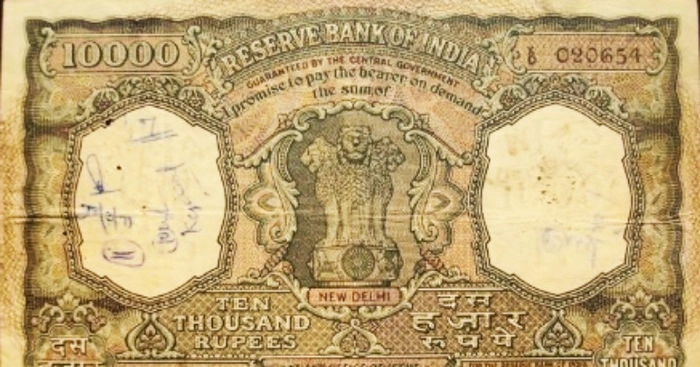Have you ever seen a 10,000 rupee note? They're pretty rare, and most people in India have probably never even laid eyes on one. But they do exist - these massive banknotes that are worth a small fortune. For a long time, the Indian government didn't even print the 10,000 rupee note. But when they finally decided to release it over 20 years ago, it created quite a stir. People were fascinated by these elusive and valuable bills. In this article, you'll learn about the origins of the 10,000 rupee note, why the government was hesitant to print them for so many years, and what made them finally decide to release this high-value banknote. The story behind India's massive 10,000 rupee note reveals some interesting aspects of the country's financial history.
Introducing the Rare and Valuable 10000 Indian Rupee Banknote
Have you ever seen a 10,000 rupee note? Most Indians haven't. This elusive bill is India's highest denomination and rarely used in everyday transactions. A Brief History The 10,000 rupee note was first introduced in 1938 under British rule. After India gained independence, the Reserve Bank of India started issuing the notes in 1954. However, high inflation and economic troubles caused the note's value to plummet, so the RBI discontinued it in 1978.
A Prized Possession: In the 1980s, India stabilized its economy and the 10,000 rupee note made a comeback. Today, it remains a prized possession for collectors. The design features a motif of the Indian national bird, the peacock, against a pattern of floral petals. Only a few million 10,000 rupee notes are in circulation, making them difficult to obtain and trade.
Uses and Regulations: The 10,000 rupee note is mainly used for large financial transactions between banks and businesses. Individuals rarely use them for daily purchases due to their high value. Strict regulations also apply to curb money laundering and tax evasion. Individuals can only exchange up to ₹50,000 in high denomination bills per week.
While the 10,000 rupee note offers a glimpse into India's complex economy and financial history, its elusive nature adds an air of mystery and intrigue. For most Indians, catching a glimpse of this rare and colorful banknote remains an unusual treat.
When and Why the 10000 Rs Note Was First Issued in India
Back in 1938, the Reserve Bank of India introduced the first 10,000 rupee note to facilitate large cash transactions. At the time, the highest denomination was only 1,000 rupees, so the larger note made it more convenient for people to carry out high-value exchanges, especially for business purposes.
Curbing Black Money: In a surprising move, the RBI suddenly demonetized the 10,000 rupee note in 1978 along with other high-value notes. The goal was to curb the flow of black money and force people to declare their actual incomes. The big notes were replaced with new series, instantly rendering the old ones worthless.
Reintroduction and Controversy: The 10,000 rupee note made a comeback in 1998 but continued to be controversial. Critics argued that such a large denomination only made it easier for people to hoard black money, dodge taxes and engage in other illegal activities. Supporters countered that the note was necessary to meet the transaction needs of India's growing economy.
The debate intensified in 2016 when the government once again demonetized the 10,000 rupee note, along with the 500 rupee note which made up nearly 86% of the currency in circulation. The move aimed to crack down on corruption and the black market economy. However, it also caused major hardship for ordinary Indians who rely heavily on cash.
The Future of High Value Notes: The future of the 10,000 rupee note remains uncertain. While it provides convenience for some, it also enables illegal activity according to its detractors. The Indian government must weigh the pros and cons carefully to determine if the benefits of such a large denomination outweigh the costs to society. One thing is clear - the note will likely continue to be controversial whichever side prevails.
Key Features and Design Elements of the 10000 Rupees Note
The 10000 Indian Rupee banknote has several security features and design elements that make it stand out. When you first see the note, the most striking feature is its large size—it’s the biggest denomination in circulation. The predominantly pink color scheme is also instantly recognizable.
Intricate Guilloche Patterns:
The 10000 Rupee note features intricate guilloche patterns, which are complex interlacing designs. These patterns are hard to reproduce and help deter counterfeiters. Closer inspection reveals the patterns contain hidden text and numerals, including the denomination of the note written in Hindi and English.
Portrait of Mahatma Gandhi:
At the center of the note is a portrait of India's famous independence leader Mahatma Gandhi. Gandhi's portrait is one of the note's most prominent anti-counterfeiting features. When the note is tilted, a hidden image of Gandhi's portrait and the denominational numeral 10000 become visible.
Microprinted Text:
The note also incorporates microprinted text, which appears as a solid line to the naked eye but contains readable text when magnified. The microprinted text includes excerpts from India's constitution and the denomination of the note in Hindi and English.
Color-Changing Ink:
Color-changing ink is another security feature of the 10000 Rupee note. When the note is tilted, a hidden numeral 10000 and the word “रुपये” (Rupees in Hindi) appear in color-changing ink. The color shifts from green to blue when the note is tilted.
Watermark:
A watermark featuring Mahatma Gandhi's portrait and the text “राष्ट्रपिता महात्मा गांधी” (Father of the Nation Mahatma Gandhi) is visible when the note is held up to the light. The watermark is made of polyester fibers embedded during paper manufacturing and provides additional security.
The 10000 Rupee note has a combination of overt and covert security features that act as a deterrent against counterfeiting. Careful scrutiny of the note's design and details allows users to verify its authenticity. The note is not only India's highest denomination but also an artistic and technological marvel.
The Journey and Controversies Around the 10000 Rs Banknote
A Long Time Coming
The RBI had contemplated introducing a Rs 10,000 note for decades to keep up with inflation, but concerns about counterfeiting and black money prevented it. Still, the demand for higher denomination notes continued from banks and the public to facilitate large transactions. Finally, in November 2016, the RBI unveiled the Rs 2,000 and brand new Rs 500 notes. The Rs 10,000 note soon followed, the highest denomination ever printed.
Fears of Misuse
Critics argued the Rs 10,000 note would make it easier for black money hoarders and counterfeiters. However, the RBI added security features like a readable microprint and a windowed security thread. Supporters countered that higher notes were needed for legitimate transactions and the illegal use of cash was better addressed through enforcement.
A Symbolic Milestone
The Rs 10,000 note holds more symbolic importance as a milestone. It highlights India’s economic progress where such a high denomination is warranted and used in daily life. Most developed nations like the US and UK also have relatively high denomination notes. However, the Rs 10,000 note still remains a rarity in everyday circulation, used more as a store of value than for transactions.
The Rs 10,000 note has been both celebrated and controversial. While its viability remains to be seen, it represents an important symbolic step as India continues its march toward becoming a global economic powerhouse. Only time will tell if the pros outweigh the cons for this prestigious purple note.
FAQs About the 10000 Indian Rupee Note: Answering Common Questions
Why was the 10000 Rupee note introduced?
The Indian government introduced the 10000 Rupee note in 2000 to make large cash transactions more efficient. Carrying bundles of 1000 Rupee notes was cumbersome, so the higher denomination note reduced the bulk. The note has Mahatma Gandhi on one side, and the Ashoka Pillar on the other.
How widely is the 10000 Rupee note used?
The 10000 Rupee note is commonly used for large cash transactions, especially in urban areas. However, some merchants are hesitant to accept such a high value note due to concerns about counterfeiting. Many people also find the note inconvenient for everyday purchases since change is often unavailable. The note works best when making bigger buys, paying rent, or transferring large sums of cash.
What security features does the 10000 Rupee note have?
The RBI has incorporated several security features to reduce counterfeiting of the 10000 Rupee note. These include a windowed security thread, color-shifting ink, microlettering, and an optically variable ink. Newer notes also have a portrait of Gandhi that appears three-dimensional, color-changing fibers, and hidden text that's only visible under UV light. These features make the notes difficult to replicate but easy to authenticate.
Will the 10000 Rupee note be discontinued?
There are no current plans to discontinue the 10000 Rupee banknote. However, the Indian government has replaced some high-value notes in the past to curb counterfeiting and illegal cash hoarding. If the 10000 Rupee note were discontinued, citizens would likely have a grace period to deposit any notes in their possession before they lose value. The RBI may also introduce a new series of the 10000 Rupee note with enhanced security features as an alternative. For now, the note remains commonly used and accepted.
Conclusion
So there you have it, the story behind the massive 10000 Rupee banknote. For you, it's just another bill in your wallet. But for India, it represents a complex economic and political history. This single banknote weaves together threads of corruption, power struggles, and the ambitions of an emerging nation. The next time you crack open your wallet and see that flash of pink, take a moment to reflect on the note's symbolic journey. Let it remind you that even simple objects can have rich backstories if you take the time to look. And who knows, maybe the money in your pocket has an unexpected tale of its own just waiting to be told.



